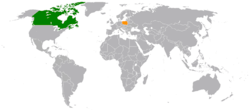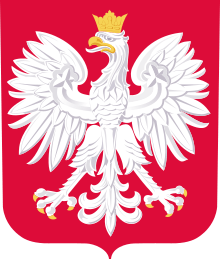Canada–Poland relations
 | |
Canada |
Poland |
|---|---|
Canada–Poland relations are foreign relations between Canada and Poland. Both countries are full members of the Organisation for Economic Co-operation and Development, NATO and the World Trade Organization.
History
The first Polish migrants to Canada arrived soon after the First Partition of Poland in the late 1700s.[1] From the 1800s to the end of communism in Poland; Canada received large waves of migration from Poland.[1]

Diplomatic relations between Canada and Poland were first established in June 1919 and carried out by the Polish embassy in London.[2] Soon after the Invasion of Poland in September 1939 by Germany, Canada joined the allies and entered World War II. In March 1942, the Polish government-in-exile opened a legation mission in Ottawa.[2] During the war, Canadian and Polish troops fought alongside during the Dieppe Raid in France in August 1942 and during the Italian Campaign in May 1945. Soon after the end of the war, both nations re-established diplomatic relations and their respective legation missions were elevated to embassies in April 1960.[2]
During the 1980s, Canada took an interest in the Polish trade union known as "Solidarność" (Solidarity) led by Lech Wałęsa. Many of the union members were arrested soon after martial law came into effect from December 1981 – July 1983. After their prison sentence, many high-ranking members of the union were offered asylum by Canada. In addition, Canada agreed to receive 6,000 Polish refugees fleeing the worsening of conditions in Poland during the increased economic and political oppression of dissidents by the government.[3] After the Polish Round Table Agreement in April 1989, Lech Wałęsa paid a visit to Canada in November 1989 paving the way for an official visit by Polish President Tadeusz Mazowiecki in 1990, the first Polish head of state to visit Canada.[4][2] Since the historic visit, there have been several high-level visits by leaders of both nations.
State visits
Prime Ministerial visits from Canada to Poland[5][6][7][8]
- Prime Minister Jean Chrétien (1999)
- Prime Minister Stephen Harper (2014, 2015)
- Prime Minister Justin Trudeau (2016)
Prime Ministerial and Presidential visits from Poland to Canada[2][9][10]
- Prime Minister Tadeusz Mazowiecki (1990)
- President Lech Wałęsa (1994)
- Prime Minister Donald Tusk (2012)
- President Andrzej Duda (2016)
Defence
In February 1998, Canada was the first NATO country to ratify Polish accession to the North Atlantic Alliance. Canada has become a leader among NATO countries in language and peacekeeping training in Poland, with hundreds of Polish officers and senior general staff having received training in Canada and Poland.
Development
The Canadian International Development Agency (CIDA) has committed $75 million for technical cooperation projects in Poland in the 1990s to support the country's transformation. Those programs stopped in 2004 with Poland's accession to the EU. Canada's support has evolved and the two countries now jointly fund development projects in third countries. CIDA's Official Development Assistance in Central Europe (ODACE) develops Poland's capacities as a donor of foreign aid.
Canadian Studies Centres and programmes are flourishing in Polish universities. To date, six Canadian Studies have been established and eight Polish universities offer numerous courses on Canada and the aspects of Canadian life.
Trade
Poland is Canada's largest market in Central and Eastern Europe. Bilateral trade totalled $799.3 million in 2005. In 2015, trade between both nations totalled $2.2 billion Canadian dollars.[11] Canadian exports to Poland in 2015 and totalled $251 million. Canadian imports from Poland were valued at $1.7 billion. Canada's main exports to Poland were primarily machinery, mineral ores, medical or surgical instruments and mineral fuel. Canadian imports from Poland included machinery, fur skins, furniture, electrical machinery, aircraft, and parts.[11] In October 2016, Canada and the European Union (which includes Poland) signed a free trade agreement known as the "Comprehensive Economic and Trade Agreement".[12]
Investment
Poland's dynamic economy and its accession to the European Union in 2004 have created opportunities for the Canadian private sector. Priority sectors of opportunity include a wide range of infrastructure projects in the transportation and oil and gas sectors, aerospace, environmental products, science and technology (information technology and telecommunications), and defence and security products. Canadian investment in Poland was $264 million in 2015.[11]
Resident diplomatic missions
- Canada has an embassy in Warsaw.[13]
- Poland has an embassy in Ottawa and consulates-general in Toronto and Vancouver and a consulate in Montreal.[14]
 Embassy of Canada in Warsaw
Embassy of Canada in Warsaw Embassy of Poland in Ottawa
Embassy of Poland in Ottawa Consulate-General of Poland in Toronto
Consulate-General of Poland in Toronto
See also
References
- 1 2 Polish Canadians
- 1 2 3 4 5 Poland and Canada: an outline of common history
- ↑ Austria braces for flood of new Polish refugees
- ↑ Lech Walesa, hero of Solidarity
- ↑ Chretien vists Nazi death camps in Poland
- ↑ PM Harper: Canada considering military options in Europe
- ↑ Ukraine discussions trump Stephen Harper's visit to Warsaw
- ↑ Prime Minister Trudeau attends NATO Summit in Warsaw
- ↑ Polish PM's visit stirs emotions on Parliament Hill
- ↑ Prime Minister Justin Trudeau meets with President Andrzej Duda of Poland
- 1 2 3 Canada-Poland Relations
- ↑ EU and Canada sign free trade agreement
- ↑ Embassy of Canada in Poland
- ↑ Embassy of Poland in Canada
.png)
